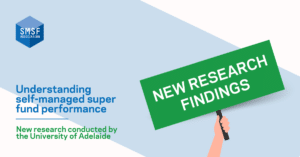- News articles
First published in the Financial Review on 23 February 2022.
It might seem counter-intuitive, but economic and social crises give SMSFs greater appeal.
After the global financial crisis (GFC) in 2008, many believed the appeal of self-managed super funds would diminish. Many also believed the investment turmoil that followed the global meltdown in financial markets would prompt individuals to seek sanctuary in the superannuation system overseen by the Australian Prudential Regulation Authority (APRA). In troubled times, the argument went, they would want their retirement savings in expert hands.
Yet, the opposite occurred. In the years after the GFC, SMSF numbers grew quite sharply as individuals sought to exert direct control over their superannuation via an SMSF, an increase that didn’t greatly perturb the Cooper review into superannuation that handed down its final report in 2010. Despite being urged to do so, that report did not recommend mandatory training of SMSF trustees (unless there had been a breach of legislation), nor did it advocate an asset minimum to establish an SMSF.
Now it has happened again. Australian Taxation Office statistics just released for 2020-21 show the largest increase in the number of SMSF establishments since 2017-18 with 25,312 new funds. On average, this equates to 2100 new funds being established every month in this period. The number of wind-ups stands at 2187, although this figure is likely to increase as the paperwork rolls through the system. The average number of wind-ups over the past four years was slightly more than 18,000.
So, the question must be asked – what’s driving this growth? Much has come from the 35-44 age group, and the ATO figures for 2019-20 (its latest statistics for this category) show that group comprises about one-third of all new establishments. If you include those aged between 25 and 34, it rises to nearly 45 per cent.
This trend for younger people to set up an SMSF, evident for more than a decade, is in stark contrast to the earlier practice where people waited until they were in their 50s and retirement was on the horizon before switching from an APRA-regulated fund to an SMSF.
It also suggests that, as in the GFC, in times of uncertainty and market volatility, individuals want to take more control over their finances and bring things closer to home. With superannuation, SMSFs provide the ultimate in terms of flexibility and control – as well as far greater responsibility.
Individuals in these younger age cohorts are more engaged with their super than the older generations of today were at the same age – they have grown up with compulsory super and have access to more information about SMSFs than ever before, so establishing their own super fund and getting into the driver’s seat is not as daunting as it once was.
Time to reflect
That people had more time during lockdowns to reflect and review their finances could also be a factor. The emergence of the SMSF specialist adviser means consumers have greater access to better advice about their funds.
Two other factors have also come to the fore. The cost of managing your own superannuation was often cited as a deterrent. But as research by the actuarial firm Rice Warner, released in late 2020, showed, SMSFs with balances of $200,000 or more are cost-competitive with industry and retail superannuation funds, and SMSFs with balances of $500,000 or more are generally the cheapest alternative.
The report also showed that those individuals with lower balances were cognisant of the cost factor and were intent on quickly getting their balances to $200,000.
The University of Adelaide International Centre for Financial Services has just published research based on 318,000 SMSFs that shows the investment performance of a typical DIY fund improves as the fund balance approaches $200,000, and that once this threshold is reached, the fund achieves comparable investment returns with APRA-regulated funds.
In contrast, current guidance from the Australian Securities and Investments Commission (ASIC) states that “on average, SMSFs with balances below $500,000 have lower returns after expenses and tax than funds regulated by APRA”.
Increasingly, younger individuals are not heeding this advice, and the research shows they are right to make this choice. It is time for ASIC to review this guidance, based on the increasing body of evidence that a $200,000 threshold provides a more appropriate level beyond which SMSFs can be competitive with larger funds – both on investment performance and operating costs.

Opinion piece written by
John Maroney, CEO,
SMSF Association




